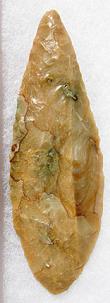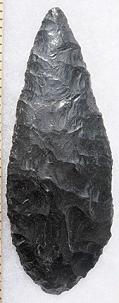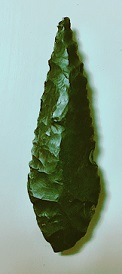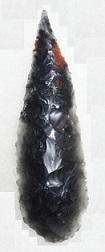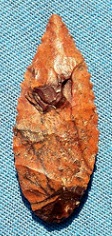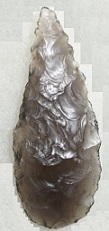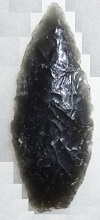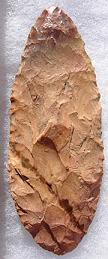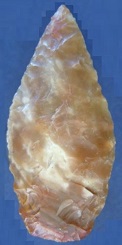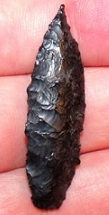Outline is Representative of Size and Shape:

Name Details:
Identified By: B. Robert Butler
Named For:
Date Identified: 1961
Type Site:
Identified By: B. Robert Butler
Named For:
Date Identified: 1961
Type Site:
Point Validity:
Valid type
Butler is a distinguished anthropologist and a professor at the Idaho State University. Butler conducted many excavations in Idaho and is an expert on point typology. This type was named in a professional publication and has many professional references. This is considered a valid type.
Butler is a distinguished anthropologist and a professor at the Idaho State University. Butler conducted many excavations in Idaho and is an expert on point typology. This type was named in a professional publication and has many professional references. This is considered a valid type.
Cascade Ovoid
Cascade Type CCluster:
Description of Physical Characteristics and Flaking Pattern:
This is a narrow medium to large ovoid point with an elliptical cross section, but may have a median ride on thick examples. The blade is excurvate, curving in at the tip and curving back in at the base giving the point a contracting hafting region. The blade is often serrated. Grinding of the hafting region is generally absent. The base is convex. The flaking pattern may vary from parallel oblique, collateral, or random.
Size Measurements:
Total Length - 25 to 90 mm (average 45 to 60 mm), Blade Width - 11 to 30 mm (average 11 to 18 mm), Thickness - 3 to 9 mm.
Total Length - 25 to 90 mm (average 45 to 60 mm), Blade Width - 11 to 30 mm (average 11 to 18 mm), Thickness - 3 to 9 mm.
Commonly Utilized Material:
The most commonly used material is obsidian and basalt followed by locally available materials. Heat treatment is not used for this type.
The most commonly used material is obsidian and basalt followed by locally available materials. Heat treatment is not used for this type.
Additional Comments:
This point is difficult to distinguish from Agate Basin type points, especially in the more eastern regions of the distribution. Cascades are considered the most prevalent late Paleo to early Archaic point found in western Montana, but unless they are found in a highly stratified site with good radiocarbon dating, it may be impossible to distinguish the two types from each other (Sturtevant and Walker, 1986).
It is thought that these points may have evolved from Agate basin points and transformed into Cold Spring, Bitterroot, and Salmon River Side Notch points.
Some examples may have a straight or concave base and has the appearance of a Humboldt type point. These two types may be distinguished by the presents of grinding on the hafting region. Humboldt points have heavy grinding on the hafting region while Cascade type point generally have an absence of hafting region grinding.
This point is difficult to distinguish from Agate Basin type points, especially in the more eastern regions of the distribution. Cascades are considered the most prevalent late Paleo to early Archaic point found in western Montana, but unless they are found in a highly stratified site with good radiocarbon dating, it may be impossible to distinguish the two types from each other (Sturtevant and Walker, 1986).
It is thought that these points may have evolved from Agate basin points and transformed into Cold Spring, Bitterroot, and Salmon River Side Notch points.
Some examples may have a straight or concave base and has the appearance of a Humboldt type point. These two types may be distinguished by the presents of grinding on the hafting region. Humboldt points have heavy grinding on the hafting region while Cascade type point generally have an absence of hafting region grinding.
Distribution: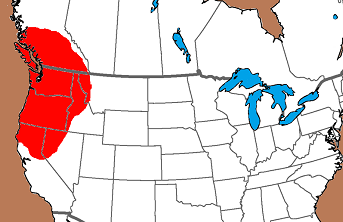

Distribution Comments:
This point is primarily found in Columbia Plateau of Washington and Oregon and into northern Idaho and western Montana. This point is found through the Cascade Range and into the northern Sierra Nevada range of California and Nevada. This point may be found into the Okanagan Range of British Columbia and extends to the coastal regions.
This point is primarily found in Columbia Plateau of Washington and Oregon and into northern Idaho and western Montana. This point is found through the Cascade Range and into the northern Sierra Nevada range of California and Nevada. This point may be found into the Okanagan Range of British Columbia and extends to the coastal regions.
Age / Periods:
Date: 8,000 - 5,000 B.P.
Cultural Period: Early to Middle Archaic
Glacial Period: Middle Holocene
Culture: Old Cordilleran Culture
Date: 8,000 - 5,000 B.P.
Cultural Period: Early to Middle Archaic
Glacial Period: Middle Holocene
Culture: Old Cordilleran Culture
Age Details:
This point is part of the Cascade Phase.
This point is part of the Cascade Phase.
Similar Points:
Agate Basin, Early Leaf, Excelsior, Haskett, Lochnore Lanceolate, Mahkin, Mauer Ovoid, Mayne Island, Need, Owl Cave, Parman, Shuswap Lanceolate, Spedis, Steamboat, Wildcat Canyon, Windust
Agate Basin, Early Leaf, Excelsior, Haskett, Lochnore Lanceolate, Mahkin, Mauer Ovoid, Mayne Island, Need, Owl Cave, Parman, Shuswap Lanceolate, Spedis, Steamboat, Wildcat Canyon, Windust
Other points in this cluster / Related / Associated Points:
Cascade Bi-Point (Kennewick), Cascade Knife, Cascade Shouldered
Cascade Bi-Point (Kennewick), Cascade Knife, Cascade Shouldered

